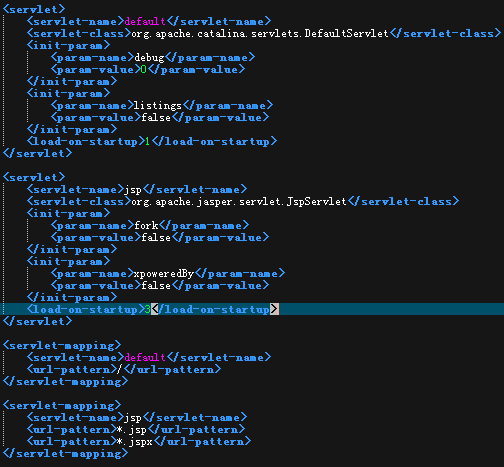基本介紹
- 中文名:filter-mapping元素過濾器映射
- 外文名:filter-mapping元素
- 映射:servlet或一個URL模式
- 元素定義:站台的名稱和說明
簡介,部署描述符,web.xml元素介紹,web.xml元素定義,web.xml元素具體描述,
簡介
filter-mapping元素用來聲明Web套用中的過濾器映射。過濾器可被映射到一個servlet或一個URL模式。將過濾器映射到一個servlet中會造成過濾器作用於servlet上。將過濾器映射到一個URL模式中則可以將過濾器套用於任何資源,只要該資源的URL與URL模式匹配。過濾是按照部署描述符的filter-mapping元素出現的順序執行的。
部署描述符
<!ELEMENT filter-mapping (filter-name,(url-pattern | servlet-name))>
<A href="javascript:linkredwin('');"><!ELEMENT filter-name (#PCDATA)>
<!ELEMENT url-pattern (#PCDATA)>
<!ELEMENT servlet-name (#PCDATA)>
<?xml version="1.0" encoding="ISO-8859-1">
<!DOCTYPE web-app
PUBLIC "-//Sun Microsystems,Inc.//DTD Web Application 2.3//EN"
<web-app>
<filter>
<filter-name>Encryption Filter</filter-name>
<filter-class>com.brainysoftware.EncryptionFilter</filter-class>
</filter>
<filter-mapping>
<filter-name>Encryption Filter</filter-name>
<servlet-name>EncryptionFilteredServlet</servlet-name>
</filter-mapping>
</web-app>
web.xml元素介紹
每一個站的WEB-INF下都有一個web.xml的設定檔案,它提供了我們站台的配置設定.
web.xml元素定義
◆站台的名稱和說明
◆針對環境參數(Context)做初始化工作
◆Servlet的名稱和映射
◆Session的設定
◆Tag library的對映
◆JSP網頁設定
◆Mime Type處理
◆錯誤處理
要了解web.xml的設定值,必須了解它的schema,從web.xml中知道它的schema是由Sun Microsystems公司定製的,如果你想更為詳細的了解它,可以到這個網頁,那裡有更為詳細的介紹。這裡我介紹我們平常見得最多的.
這是一般在寫XML時所做的聲明,定義了XML的版本,編碼格式,還有重要的指明schema的來源。
web.xml元素具體描述
< description>;站台描述< /discription>
對站台做出描述.
< display-name>;站台名稱< /display-name>
定義站台的名稱.
< icon>
icon元素包含small-icon和large-icon兩個子元素.用來指定web站台中小圖示和大圖示的路徑.
< small-icon>/路徑/smallicon.gif< /small-icon>
small-icon元素應指向web站台中某個小圖示的路徑,大小為16 X 16 pixel,但是圖象檔案必須為GIF或JPEG格式,擴展名必須為:.gif或.jpg.
< large-icon>/路徑/largeicon-jpg< /large-icon>
large-icon元素應指向web站台中某個大圖表路徑,大小為32 X 32 pixel,但是圖象檔案必須為GIF或JPEG的格式,擴展名必須為; gif 或jpg.
範例:
< display-name>Develop Example< /display-name> < description>JSP 2.0 Tech Book's Examples< /description> < icon> < small-icon>/images/small.gif< /small-icon> < large-icon>/images/large.gir< /large-icon> < /icon> < distributable>
distributable 元素為空標籤,它的存在與否可以指定站台是否可分散式處理.如果web.xml中出現這個元素,則代表站台在開發時已經
被設計為能在多個JSP Container 之間分散執行.
< context-param>
context-param 元素用來設定web站台的環境參數(context),它包含兩個子元素:
param-name和param-value.
< param-name>;參數名稱< /param-name>
設定Context名稱
< param-value>;值< /param-value>
設定Context名稱的值
範例:
< context-param> < param-name>param_name< /param-name> < param-value>param_value< /param-value> < /context-param> 此所設定的參數,在JSP網頁中可以使用下列方法來取得:
${initParam.param_name}
若在Servlet可以使用下列方法來獲得:
String param_name=getServletContext().getInitParamter("param_name");
< filter>
filter元素用來聲明filter的相關設定.filter元素除了下面介紹的的子元素之外,還包括< servlet>;介紹過的< icon>,< display-name>,< description>,< init-param>;,其用途一樣.
< filter-name>Filter的名稱< /filter-name>
定義Filter的名稱.
< filter-class>Filter的類名稱< /filter-class>
定義Filter的類名稱.例如:com.foo.hello
範例:
< filter> < filter-name>setCharacterEncoding< /filter-name> < filter-class>coreservlet.SetCharacterEncodingFilter< /filter-class> < init-param> < param-name>encoding< /param-name> < param-value>GB2312< /param-value> < /init-param> < /filter> < filter-mapping>
filter-mapping 元素的兩個主要子元素filter-name和url-pattern.用來定義Filter所對應的URL.
< filter-name>Filter的名稱< /filter-name>
定義Filter的名稱.
< url-pattern>URL< /url-pattern>
Filter所對應的URL.例如:< url-pattern>/Filter/Hello< /url-pattern>
< servlet-name>Servlet的名稱< servlet-name>
定義servlet的名稱.
< dispatcher>REQUEST|INCLUDE|FORWARD|ERROR< /dispatcher>
設定Filter對應的請求方式,有RQUEST,INCLUDE,FORWAR,ERROR四種,默認為REQUEST.
範例:
< filter-mapping> < filter-name>GZIPEncoding< /filter-name> < url-pattern>/*< /url-pattern> < /filter-mapping> < listener>
listener元素用來定義Listener接口,它的主要子元素為< listener-class>
< listen-class>Listener的類名稱< /listener-class>
定義Listener的類名稱.例如: com.foo.hello
範例:
< listener> < listener-class>coreservlet.ContenxtListener< /listener-class> < /listener> < servlet-mapping>
servlet-mapping元素包含兩個子元素servlet-name和url-pattern.用來定義servlet所對應URL.
< servlet-name>Servlet的名稱< /servlet-name>
定義Servlet的名稱.
< url-pattern>Servlet URL< /url-pattern>
定義Servlet所對應的RUL.例如:< url-pattern>/Servlet/Hello< /url-pattern>
範例:
< servlet-mapping> < servlet-name>LoginChecker< /servlet-name> < url-pattern>/LoginChecker< /url-pattern> < /servlet-mapping> < session-config>
session-config包含一個子元素session-timeout.定義web站台中的session參數.
< session-timeout>;分鐘< /session-timeout>
定義這個web站台所有session的有效期限.單位為分鐘.
範例:
< session-config> < session-timeout>20< /session-timeout> < /session-config> < mima-mapping>
mime-mapping包含兩個子元素extension和mime-type.定義某一個擴展名和某一MIME Type做對映.
< extension>;擴展名名稱< /extension>
擴展名稱
< mime-type>MIME格式< /mime-type>
MIME格式.
welcome-file-list包含一個子元素welcome-file.用來定義首頁列單.
< welcome-file>;用來指定首頁檔案名稱稱< /welcome-flie>
welcome-file用來指定首頁檔案名稱稱.我們可以用< welcome-file>;指定幾個首頁,而伺服器會依照設定的順序來找首頁.
範例:
< welcome-file-list> < welcome-file>index.jsp< /welcome-file> < welcome-file>index.htm< /welcome-file> < /welcome-file-list> < error-page>
error-page元素包含三個子元素error-code,exception-type和location.將錯誤代碼(Error Code)或異常(Exception)的種類對應
到web站台資源路徑.
< error-code>;錯誤代碼< /error-code>
HTTP Error code,例如: 404
< exception-type>Exception< /exception-type>
一個完整名稱的Java異常類型
< location>/路徑< /location>
在web站台內的相關資源路徑
範例:
< error-page> < error-code>404< /error-code> < location>/error404.jsp< /location> < /error-page> < error-page> < exception-type>java.lang.Exception< /exception-type> < location>/except.jsp< /location> < /error-page> < jsp-config>
jsp-config元素主要用來設定JSP的相關配置,< jsp:config>;包括< taglib>;和< jsp-property-group>;兩個子元素.其中< taglib>;元素
在JSP 1.2時就已經存在了;而< jsp-property-group>;是JSP 2.0新增的元素.
< taglib>
taglib元素包含兩個子元素taglib-uri和taglib-location.用來設定JSP網頁用到的Tag Library路徑.
< taglib-uri>URI< /taglib-uri>
taglib-uri定義TLD檔案的URI,JSP網頁的taglib指令可以經由這個URI存取到TLD檔案.
< taglib-location>/WEB-INF/lib/xxx.tld< /taglib-laction>
TLD檔案對應Web站台的存放位置.
< jsp-property-group>
jsp-property-group元素包含8個元素,分別為:
< description>Description< /descrition>
此設定的說明
< display-name>Name< /display-name>
此設定的名稱
< url-pattern>URL< /url-pattern>
設定值所影響的範圍,如:/CH2 或者/*.jsp
< el-ignored>true|false< /el-ignored>
若為true,表示不支持EL語法.
< scripting-invalid>true|false< /scripting-invalid>
若為true表示不支持< %scription%>;語法.
< page-encoding>encoding< /page-encoding>
設定JSP網頁的編碼
< include-prelude>.jspf< /include-prelude>
設定JSP網頁的抬頭,擴展名為.jspf
< include-coda>.jspf< /include-coda>
設定JSP網頁的結尾,擴展名為.jspf
範例:
< jsp-config> < taglib> < taglib-uri>Taglib< /taglib-uri> < taglib-location>/WEB-INF/tlds/MyTaglib.tld< /taglib-location> < /taglib> < jsp-property-group> < description> Special property group for JSP Configuration JSP example. < /description> < display-name>JSPConfiguration< /display-name> < uri-pattern>/*< /uri-pattern> < el-ignored>true< /el-ignored> < page-encoding>GB2312< /page-encoding> < scripting-inivalid>true< /scripting-inivalid> ............ < /jsp-property-group> < /jsp-config> < resource-ref>
resource-ref元素包括五個子元素description,res-ref-name,res-type,res-auth,res-sharing-scope.利用JNDI取得站台可利用資源.
< description>;說明< /description>
資源說明
< rec-ref-name>;資源名稱< /rec-ref-name>
資源名稱
< res-type>;資源種類< /res-type>
資源種類
< res-auth>Application|Container< /res-auth>
資源由Application或Container來許可
< res-sharing-scope>Shareable|Unshareable< /res-sharing-scope>
資源是否可以共享.默認值為 Shareable
範例:
< resource-ref> < description>JNDI JDBC DataSource of JSPBook< /description> < res-ref-name>jdbc/sample_db< /res-ref-name> < res-type>javax.sql.DataSoruce< /res-type> < res-auth>Container< /res-auth> < /resource-ref> 以上就對web.xml元素中的常見設定值進行了介紹。本文來自l101y1982j的部落格:《web.xml詳解》

